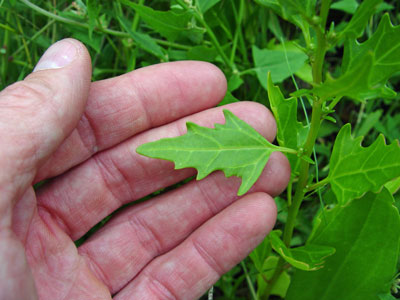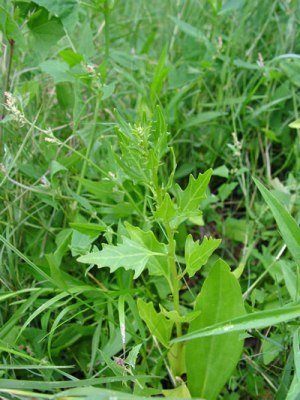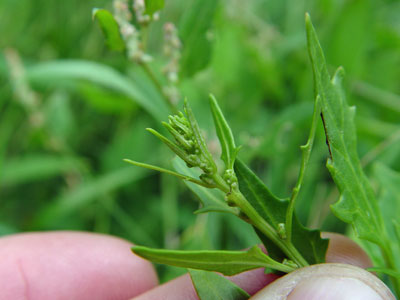DACF Home → Bureaus & Programs → Maine Natural Areas Program → Communities, Plants, and Animals → Rare Plants → Chenopodium rubrum

Chenopodium rubrum L. var. rubrum
Coast-blite Goosefoot
- State Rank: SH
- Global Rank: G5
- State Status: Potentially Extirpated
Habitat: Saltmarshes or saline soils. [Tidal wetland (non-forested, wetland)]
Range: Newfoundland to Washington, south to New England, New Jersey, and west to southern California. Considered rare in New Brunswick and New Hampshire, but not southward.

Aids to Identification: Resembles the common garden weed lamb's-quarters (C. album, an introduced species), with narrow spikes of green flowers rising out of the leaf axils. Coast-blite goosefoot, however, has leaves which are green on both sides (as opposed to the whitish leaf undersides of lamb's-quarters) and which are coarsely toothed. C. rubrum var. rubrum’s name derives from the reddish color of the late-season leaves and fruits, coloration that can also occur in C. album. Another relative found in similar habitats, orach (Atriplex patula), has leaves which are entire except for two lobes at the base. C. rubrum var. rubrum is closely related to the introduced C. rubrum var. humile. C. rubrum var. rubrum is upright, with toothed lower leaves and achenes 0.5-0.6 mm long; C. rubrum var. humile is spreading with the lower leaves entire and with the achenes 0.8_1.0 mm long.
Ecological characteristics: Can grow either on sandy frontal dunes or, less commonly, in grass- or sedge-dominated marshes back from the shore. Common dune associates include sea rocket (Cakile edentula), orach (Atriplex patula), sea-beach sandwort (Honckenya peploides), etc.

Phenology: Flowers August - November; fruits September on.
Family: Amaranthaceae
Synonyms: Chenopodium rubrum L. var rubrum is native, though Chenopodium rubrum L. var humile (Hook.) S. Wats is non-native and was formerly tracked under its synonym, Chenopodium humile Hook.
Known Distribution in Maine: This rare plant has been documented from a total of 7 town(s) in the following county(ies): Lincoln, Sagadahoc, Washington, York.
Reason(s) for rarity: Unclear; perhaps overlooked; near northern end of its range.
Conservation considerations: Need more information; populations could be threatened by heavy recreational use.